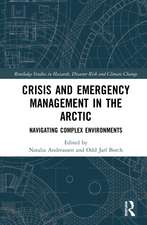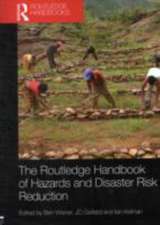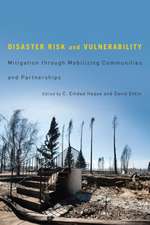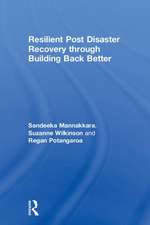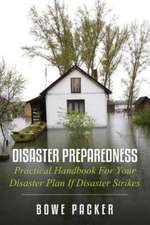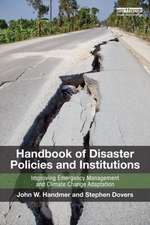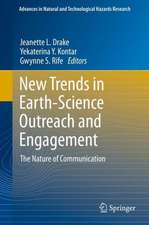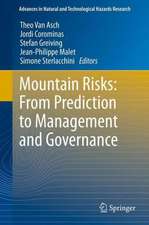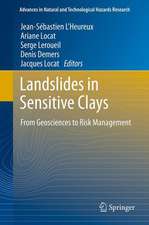The Angry Earth: Disaster in Anthropological Perspective
Editat de Anthony Oliver Smith, Susanna Hoffmanen Limba Engleză Paperback – 24 dec 2019
From hurricanes, floods, and earthquakes to oil spills and nuclear accidents, disasters triggered by both natural and technological hazards have become increasingly frequent and destructive across the planet. Through case studies drawn from around the globe the contributors to this volume examine issues ranging from the social and political factors that set the stage for disaster, to the cultural processes experienced by survivors, to the long-term impact of disasters on culture and society. In the second edition, each chapter has been updated with a postscript to reflect on recent developments in the field. There is also new material on key present-day topics including epidemics, drought, non-governmental organizations, and displacement and resettlement.
This book demonstrates the relevance of studying disaster from an anthropological perspective and is a valuable resource not only for anthropologists but for other fields concerned with education, policy and practice.
| Toate formatele și edițiile | Preț | Express |
|---|---|---|
| Paperback (1) | 459.89 lei 6-8 săpt. | |
| Taylor & Francis – 24 dec 2019 | 459.89 lei 6-8 săpt. | |
| Hardback (1) | 772.79 lei 6-8 săpt. | |
| Taylor & Francis – 10 dec 2019 | 772.79 lei 6-8 săpt. |
Preț: 459.89 lei
Nou
Puncte Express: 690
Preț estimativ în valută:
88.00€ • 92.54$ • 72.71£
88.00€ • 92.54$ • 72.71£
Carte tipărită la comandă
Livrare economică 17 aprilie-01 mai
Preluare comenzi: 021 569.72.76
Specificații
ISBN-13: 9781138237841
ISBN-10: 1138237841
Pagini: 418
Ilustrații: 13 Tables, black and white; 12 Line drawings, black and white; 12 Illustrations, black and white
Dimensiuni: 174 x 246 x 22 mm
Greutate: 0.7 kg
Ediția:Nouă
Editura: Taylor & Francis
Colecția Routledge
Locul publicării:Oxford, United Kingdom
ISBN-10: 1138237841
Pagini: 418
Ilustrații: 13 Tables, black and white; 12 Line drawings, black and white; 12 Illustrations, black and white
Dimensiuni: 174 x 246 x 22 mm
Greutate: 0.7 kg
Ediția:Nouă
Editura: Taylor & Francis
Colecția Routledge
Locul publicării:Oxford, United Kingdom
Public țintă
Postgraduate and UndergraduateCuprins
List of Figures and Tables
Acknowledgements
Note on Contributors
Introduction to the Second Edition of The Angry Earth: From Introduction to Widespread Reception (Susanna M. Hoffman and Anthony Oliver-Smith)
Introduction to the First Edition. Anthropology and the Angry Earth: An Overview (Susanna M. Hoffman and Anthony Oliver-Smith)
I. DISASTERS, ENVIRONMENT AND CULTURE
IV. HOW CULTURES RESPOND
Index
Acknowledgements
Note on Contributors
Introduction to the Second Edition of The Angry Earth: From Introduction to Widespread Reception (Susanna M. Hoffman and Anthony Oliver-Smith)
Introduction to the First Edition. Anthropology and the Angry Earth: An Overview (Susanna M. Hoffman and Anthony Oliver-Smith)
I. DISASTERS, ENVIRONMENT AND CULTURE
- What is a Disaster? Anthropological Perspectives on a Persistent Question (Anthony Oliver-Smith)Postscript: Hazards of Nature, Disasters of Society
II. ENVIRONMENTAL PATTERN, HAZARDS AND CULTURE: THE ARCHEOLOGICAL PERSPECTIVE - Convergent Catastrophes: Geoarcheological Perspectives on Collateral Natural Disasters and Cultural Change in the Central Andes (Michael E. Moseley)Postscript: Convergent Catastrophe: Past Patterns and Future Implications of Collateral natural Disaster in the Andres
- Explosive Volcanic Eruptions and Societal Responses: A Comparative Archeological Study in Middle America (Payson Sheets)Postscript: When the Natural Hazard Becomes a Cultural Disaster
III. THE CULTURAL CONSTRUCTION OF CATASTROPHE - Peru’s Five-Hundred Year Earthquake: Vulnerability in Historical Context (Anthony Oliver-Smith)Postscript: The Five Hundred Year Earthquake: Seeking Root Causes and Deep Drivers
- Examining Vulnerability to Natural Disasters: A Comparative Analysis of Four Southern California Communities After the Northridge Earthquake (Lois Stanford and Robert Bolin)Postscript: Vulnerability Then and Now
- The Negation of a Disaster: The Media Response to Oils Spills in Great Britain (Gregory V. Button)
IV. HOW CULTURES RESPOND
- "The Worst of Times, the Best of Times": Toward a Model of Cultural Response to Disaster (Susanna M. Hoffman)Postscript: Behind the States and Act Four: More to the Worst of Times, the Best of Times Model
- Vulnerability, Disaster, and Survival in Bangladesh: Three Case Studies (Mohammad Q. Zaman)Postscript: Integrated Approach to Risk Reduction and Development
- "Tell Them We’re Hurting": Hurricane Andrew, the Culture of Response, and the Fishing Peoples of South Florida and Louisiana (Christopher L. Dyer and James M. McGoodwin)Postscript: Recognizing the Diversity of Disaster Impacts: The Need for Response Protocols, Anticipation, and Human Rights
- Epidemics and Disasters: From the Venezuela Delta Amacuro to the Mississippi Wetlands (Charles Briggs and Anne M. Lovell)
- Drought: A Challenge to Livelihoods, Sustainability, and Resilience (J. Terrence McCabe and Amy Quandt)
- The Brotherhood of Pain: Emotion and Social Organization in the Crisis of Disaster (Anthony Oliver-Smith)Postscript: Communitas and Resilience
- The Regenesis of Traditional Gender Patterns in the Wake of Disaster (Susanna M. Hoffman)Postscript: Still With Us After all These Years; But Slowly Changing
V. AGENCIES, SURVIVORS AND CULTURE - Plan and Pattern in Reaction to Earthquake: Peru, 1970-1998 (Paul L. Doughty)Postscript: Revisiting a Scene of Disaster, Again
- Bhopal and Beyond: An Anthropology of Relief and Rehabilitation Efforts and Prospects for a Socially Relevant Political Ecology of Disaster Management (Ravi Rajan)Postscript: The Bhopal Gas Disaster Three Decades On
- The Phoenix Effect in Post-Disaster Recovery: An Analysis of the Economic Development Administration's Culture of Response After Hurricane Andrew (Christopher L. Dyer)Postscript: The Phoenix Effect Revisited: Hurricane Andrew, South Florida, and the Rise of Punctuated Entropy
- Disaster Anthropology in Non-Governmental Organizations (Adam Koons)
- Disaster and Climate Change-related Displacements and Resettlements: Cultural and Political Ecologies of Space, Power, and Practice (A.J. Faas, Roberto Barrios, Elizabeth Marino, and Julie Maldonado)VI. DISASTER AND CULTURAL CONTINUITY
- Islands on an Angry Earth: Climate Change, Disasters, and Implications for Two Island Communities (Heather Lazrus and Carlos Arenas)
- After Atlas Shrugs: Cultural Persistence and Perpetuation in the Context of Disaster (Susanna Hoffman)
Index
Notă biografică
Anthony Oliver-Smith is a professor emeritus in the Department of Anthropology at the University of Florida, USA. He has done anthropological research and consultation on issues relating to disasters and involuntary resettlement in Peru, Honduras, India, Brazil, Jamaica, Mexico, Japan, Panama, and the United States since the 1970s. His current work is concerned with climate change, disasters, displacement, and migration. He is a recipient of the Bronislaw Malinowski Lifetime Achievement Award given by the Society for Applied Anthropology.
Susanna M. Hoffman is an internationally recognized expert on disaster. She is the author, co-author, and editor of twelve books, two ethnographic films, and more than forty articles and chapters. She initiated the Risk and Disaster Thematic Interest Group for the Society for Applied Anthropology, and is the founder and chair of the Risk and Disaster Commission for the International Union of Anthropology and Ethnographic Sciences. She was the first recipient of the Fulbright Foundation’s Aegean Initiative dealing with the Greek and Turkish earthquakes, and helped write the United Nations Statement on Women and Disasters. She is a frequent national and international speaker, and also serves on the Task Force on World Food Problems.
Susanna M. Hoffman is an internationally recognized expert on disaster. She is the author, co-author, and editor of twelve books, two ethnographic films, and more than forty articles and chapters. She initiated the Risk and Disaster Thematic Interest Group for the Society for Applied Anthropology, and is the founder and chair of the Risk and Disaster Commission for the International Union of Anthropology and Ethnographic Sciences. She was the first recipient of the Fulbright Foundation’s Aegean Initiative dealing with the Greek and Turkish earthquakes, and helped write the United Nations Statement on Women and Disasters. She is a frequent national and international speaker, and also serves on the Task Force on World Food Problems.
Descriere
This book explores how various cultures in different historical moments have responded to calamity. It demonstrates the relevance of studying disaster from an anthropological perspective and provide a valuable resource not only for anthropologists but for other fields concerned with education, policy and practice.



